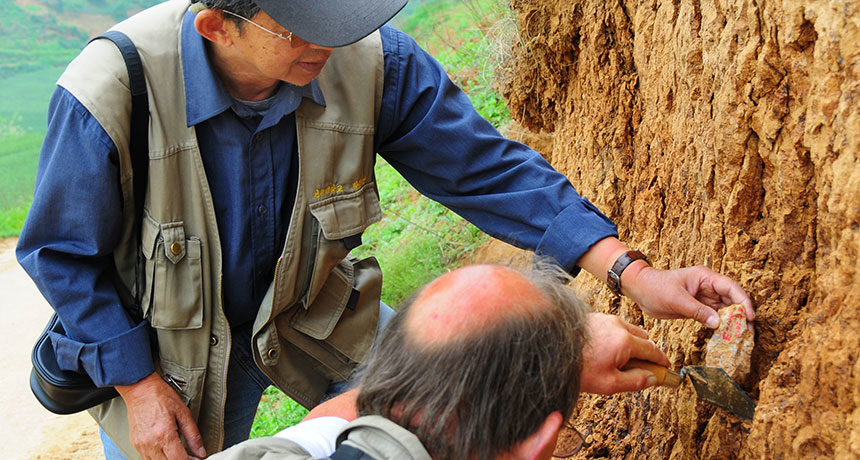
Some stone tools unearthed at China's Shangchen site date to roughly 250,000 years before what was previously the oldest Eurasian evidence of Homo, say geologist Zhaoyu Zhu of the Chinese Academy of Sciences in Guangzhou and his colleagues. Toolmakers visited the Chinese spot on and off until as late as 1.26 million years ago, the scientists report online July 12 in Nature. No hominid fossils have been found at Shangchen.
Until now, the Dmanisi site, in the western Asia nation of Georgia, had yielded the oldest hominid remains outside Africa. Homo erectus fossils unearthed at Dmanisi date to between 1.85 million and 1.77 million years ago (SN: 11/16/13, p. 6).
"An early form of Homo probably made the Shangchen artifacts, but it's too early to say if that was H. erectus," says coauthor Robin Dennell, an archaeologist at the University of Exeter in England.
After learning how to make stone flakes sharp enough to slice meat off animals' carcasses around 2.6 million years ago, African hominids may have had the survival skills to fan out into Asia and reach Shangchen by 2.1 million years ago, Dennell says.
Whatever Homo species made that roughly 7,000-kilometer journey, Shangchen now stands as the oldest hominid site in China by some 400,000 years, says archaeologist Michael Petraglia of the Max Planck Institute for the Science of Human History in Jena, Germany. Petraglia did not participate in the new study.
Between 2004 and 2017, Zhu's team excavated a series of sediment layers stacked within a 74-meter-long slope in a mountainous part of central China. Digging revealed 96 stone artifacts that showed no signs of having shifted from their original positions after being covered by soil, allowing them to be dated reliably. Implements included pieces of stone with sharpened edges or pointed tips, as well as chunks of rock with flat surfaces where toolmakers had pounded off cutting tools.
Shangchen lacks volcanic rock that can be used to estimate a site's age. Instead, the researchers identified ancient reversals of Earth's magnetic field recorded in minerals within the Chinese site's sediment. Dates for those geologic events came from published age estimates for ancient reversals of Earth's magnetic field documented at sites in Africa and elsewhere in the world.
A previously dated magnetic reversal that corresponds to the oldest one at Shangchen dates to at least 1.95 million years old, not 2.12 million years, says archaeologist and geologist Reid Ferring of the University of North Texas in Denton. Even so, that quibble over dating isn't enough to change Shangchen's status as the oldest known hominid site outside Africa, says Ferring, who has participated in excavations and sediment analyses at Dmanisi.
"The most logical conclusion of this new discovery is that Dmanisi is not the earliest evidence of occupations in Eurasia." African departures 2 million years ago or more must have led to hominids' presence at Dmanisi and Shangchen, he says. Perhaps, like nonhuman carnivores, early Homo traveled far and fast simply by trailing prey animals across the landscape, hunting them and reproducing along the way, Ferring suggests.
Citations
Z. Zhu et al. Hominin occupation of the Chinese Loess Plateau since about 2.1 million years ago. Nature. Published online July 12, 2018. doi: 1038/s41586-018-0299-4.
Further Reading
B. Bower. Fossil skull points to single root for human evolution. Science News. Vol. 184, November 16, 2013, p. 6.



Reader Comments